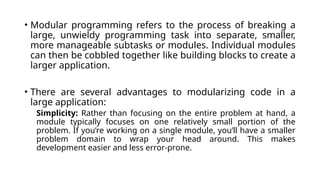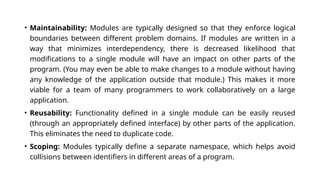Modules and its usage in python for beginners
- 2. • Modular programming refers to the process of breaking a large, unwieldy programming task into separate, smaller, more manageable subtasks or modules. Individual modules can then be cobbled together like building blocks to create a larger application. • There are several advantages to modularizing code in a large application: Simplicity: Rather than focusing on the entire problem at hand, a module typically focuses on one relatively small portion of the problem. If you’re working on a single module, you’ll have a smaller problem domain to wrap your head around. This makes development easier and less error-prone.
- 3. • Maintainability: Modules are typically designed so that they enforce logical boundaries between different problem domains. If modules are written in a way that minimizes interdependency, there is decreased likelihood that modifications to a single module will have an impact on other parts of the program. (You may even be able to make changes to a module without having any knowledge of the application outside that module.) This makes it more viable for a team of many programmers to work collaboratively on a large application. • Reusability: Functionality defined in a single module can be easily reused (through an appropriately defined interface) by other parts of the application. This eliminates the need to duplicate code. • Scoping: Modules typically define a separate namespace, which helps avoid collisions between identifiers in different areas of a program.
- 4. Python Modules: • There are three different ways to define a module in Python: • A module can be written in Python itself. • A module can be written in C and loaded dynamically at run- time, like the re (regular expression) module. • A built-in module is intrinsically contained in the interpreter, like the itertools module.
- 5. The import Statement • Module contents are made available to the caller with the import statement. The import statement takes many different forms, shown below. import <module_name> The simplest form is the one already shown above: import <module_name>
- 6. from <module_name> import <name(s)> • An alternate form of the import statement allows individual objects from the module to be imported directly into the caller’s symbol table: • from <module_name> import <name(s)>






